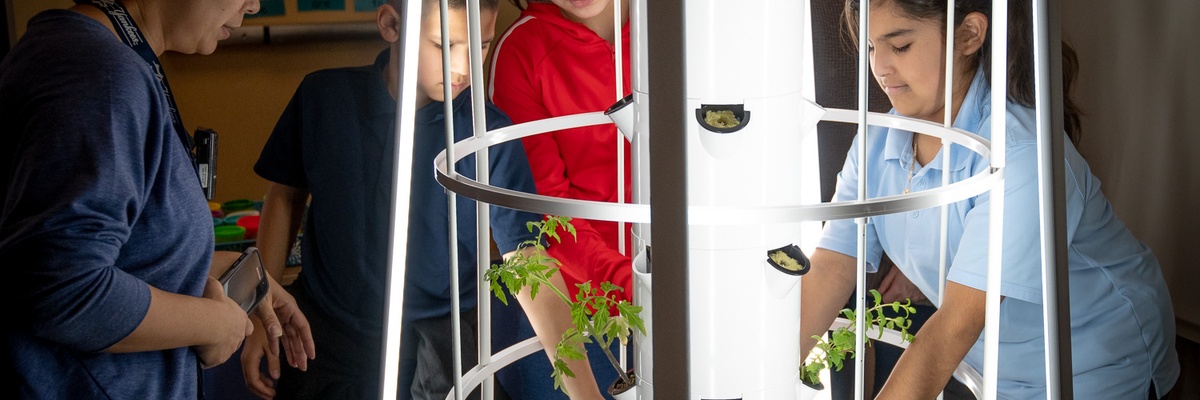Learn more about vertical gardening
Thousands of schools across the US are using vertical tower gardens to grow food in the classroom. The aeroponic technology — compared to soil gardening — has been shown to increase yields by as much as 30% and triple the speed of plant growth, while using only 10% of the water and space. You'll also get access to lesson plans that allow you to teach students about a variety of subjects including science, math, literacy, and, of course, healthy eating!
The program allows you to engage your class with a hands-on, project-based learning experience that can improve school attendance and student test performance. It allows you to elevate diets as well as minds as students learn about the benefits of healthy eating. You can grow where the learning happens, whether that’s in a classroom, greenhouse or laboratory it's up to you! The aeroponic system lowers the likelihood of bugs and don't use soil (so, no messy students!)
Here's an intro video that demonstrates how exactly the vertical tower garden works:
Purchase your Garden
Once you've completed your 30 Day Challenge to unlock the funding available for you to kick-start this project in your classroom, you'll be ready to purchase your garden. The initial costs listed below will provide you with a full tower garden growing system, equipped with enough materials to support growth for approximately 3 months. There are many variables that determine how long initial materials will last, such as classroom temperature, humidity, tap water pH, and which plants you decide to grow (some are much thirstier than others).
- Tower Garden Growing System - tower garden itself, along with a 20 gal reservoir to house water and nutrients. The following are included with the growing system: water pump & timer, pH kit, Mineral Blend A & B, Seed starting kit, Seeds, Rockwool, Net pots
- LED Lighting Kit - the lighting kit allows indoor plant growth. It comes with a timer so that the lights are automatically controlled, and can be adjusted to be on during the day, or at night while students are away.
- Tower Garden Dolly - The garden can be set up on top of a dolly with wheels, so that the garden can be easily transported around the classroom or throughout the school.
- Tomato Cage - The tomato cage allows support for plant growth. Being that it is a vertical garden, as plants grow, they grow up and downward. The cage ensures that the plants are supported and do not shade out other plants as they grow bigger.
- Ongoing items you'll need to purchase
- Rockwool
- Net pots
- Seedling Starting Kit
- Tower Garden Mineral Blend
- Tower Garden pH kit
The total price should not exceed $1,100, including shipping.
Buy your garden at Tower Garden's Online Shop
Set up the Garden
Setting up the tower garden in your classroom will take approximately 20-60 minutes depending on how much you’d like to engage students.
Tearsa from the Arizona Sustainability Alliance will come to your classroom and help you get set up for success!
You'll need to allocate a space in the classroom for the garden, a 3x3 foot space near an open outlet is most convenient.
Here's a helpful blogpost that brings you through practical tips on making your garden a success.
Start Growing
Once your garden is set up, it's time to start planting seeds and growing food!
TowerGarden.com has a host of resources that will help you to incorporate the gardening and food growing into your daily lesson plans. In the resources section you'll find the food Growing 101 Guide which gives you an overview how to bring science, math, and other curricular areas to life through your vertical garden.
You can find a full suite of CCSS- and NGSS-aligned lesson plans and learning materials here on the tower garden website
Ongoing maintenance and harvesting
Caring for a Tower Garden is relatively simple and one of the best things about having a tower garden in the classroom is that they are easy enough for students to help maintain. The garden needs one weekly check in to monitor the water pH and adjust it with the pH solution if necessary. The water level also needs to be checked, if the water is low enough that it is exposing the pump, then the reservoir needs to be filled back up and more minerals need to be added. In the past, we have found it successful to assign willing students the task of checking the garden each week, and monitoring pH and water level. When it comes time to fill the garden, or harvest the delicious food, the class can complete this as a group activity, with teacher help and supervision.
Food can be grown in your tower garden all year round, do all you need to do is repeat steps 3-5 and continue to learn and grow with your students.









 "Welcome to the Sow it Forward Vertical School Gardens program. Here you'll find an overview of what's involved in getting this program up and running in your classroom. I'll be on hand to help and support you along the way!"
- Tearsa Saffell, Arizona Sustainability Alliance
"Welcome to the Sow it Forward Vertical School Gardens program. Here you'll find an overview of what's involved in getting this program up and running in your classroom. I'll be on hand to help and support you along the way!"
- Tearsa Saffell, Arizona Sustainability Alliance
